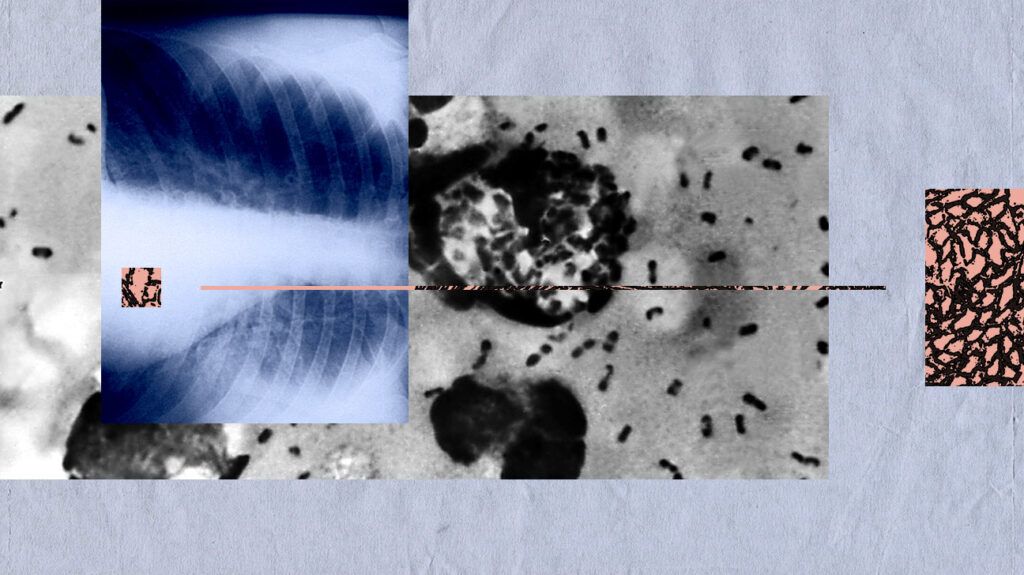Pneumonic plague occurs when plague bacteria enter the lungs. It is the only form of plague that can spread between people. Symptoms may include headache, fever, and rapidly developing pneumonia.
Plague can affect humans and other mammals. The bacteria that causes plague, Yersinia pestis, typically transmits through flea bites but can also spread by other means.
The disease requires prompt treatment with antibiotics. Pneumonic plague is the most severe form of the condition and can be fatal without treatment.
This article explores pneumonic plague in more detail, including its causes, symptoms, and diagnosis. The article also discusses how doctors treat pneumonic plague and how people can help prevent its transmission.

Yersinia pestis is the bacteria that causes plague. There are
- bubonic plague
- septicemic plague
- pneumonic plague
Plague affects nonhuman animals across all continents, except Oceania, according to the
Yersinia pestis can
- Fleabites: The bacteria most commonly transmits through bites from fleas. Plague outbreaks typically affect rodents. If a rodent dies from the disease, fleas that were feeding on them start to feed on other animals, such as dogs and cats. These animals may then carry bacteria-containing fleas into closer proximity to people.
- Contact with bacteria-containing body fluids or tissues: The bacteria may spread to a person if they handle the tissue or body fluids of an animal with the disease. For example, if a hunter skins an animal without using gloves or following other proper precautions, they may contract Yersinia pestis. People most commonly develop bubonic or septicemic plague from this type of exposure.
- Bacteria-containing droplets: If humans and other mammals have pneumonic plague, they may cough bacteria-containing droplets into the air. These droplets can cause pneumonic plague if a person or nonhuman mammal inhales them, typically following direct or close contact with a person or nonhuman animal with the disease. This is the only way that plague can spread between people.
Pneumonic plague can also develop when Yersinia pestis spreads to the lungs of someone with untreated bubonic or septicemic plague.
According to the WHO,
These symptoms may come on suddenly.
Additionally, pneumonic plague may cause
- shortness of breath
- cough, which may produce bloody or watery mucus
- chest pain
If someone develops pneumonic plague after the bacteria has spread to the lungs due to untreated bubonic or septicemic plague, they may experience other symptoms, such as swollen lymph nodes.
People need to seek immediate medical attention if they are experiencing the above symptoms. Without treatment, plague can lead to potentially life threatening complications.
A doctor
However, there may not be any obvious signs of pneumonic plague.
Therefore, healthcare professionals
Doctors may begin treatment for plague before confirming the final test results to help prevent complications.
Healthcare professionals
The earlier a person receives treatment, the better their outlook. According to the WHO, pneumonic plague can be fatal
Doctors may also need to treat complications of plague.
Additionally, they may evaluate people who have been in close contact with someone with pneumonic plague. In some cases, they may put them under observation and prescribe preventive antibiotics.
Individuals who live in areas where plague outbreaks are more likely to occur can take the
- Rodent proof the home and yard: People need to store pet and wild animal food in well-sealed containers. A person also needs to remove potential rodent habitats surrounding their home, such as rock piles or cluttered firewood.
- Take hygiene precautions: A person needs to avoid contact with dead animals and contact their local health department to learn about disposing of them safely. People need to wear gloves if they are handling animals that may have contracted plague.
- Use insect repellent: Individuals need to apply insect repellent during activities, such as hiking, camping, or working outdoors, in case of exposure to fleas. They can apply products containing permethrin to clothes and DEET to the skin.
- Use flea control products on pets: Animals that roam freely may acquire fleas. People can help prevent fleas by applying flea control products to their pets. They also need to take their pet to a veterinarian if it contracts fleas or becomes sick.
- Keep pets off beds: A person needs to prevent pets that roam freely from sleeping on their bed.
The WHO
A 2022 review suggested that while pneumonic plague outbreaks are relatively rare at present, the following factors could contribute to the risk of future outbreaks:
- Antibiotic resistance: Similar to other types of bacteria, Yersinia pestis can develop resistance to certain antibiotics. Previous research has documented some antibiotic-resistant strains of Yersinia pestis.
- Climate change: Changes in environmental factors, such as temperature and humidity, can affect how quickly and far infectious diseases spread. This may mean outbreaks are more likely in certain areas.
- Bioweaponry: Some studies suggest that plague is a potential candidate as a future bioweapon. People have used bacteria-containing fleas and dead bodies as bioweapons during wars in the past.
People can help combat antibiotic resistance by taking antibiotics only when necessary and exactly as their doctor has instructed.
Many factors contributing to climate change require systemic change. However, a person can also make lifestyle changes, such as following a sustainable diet, to help reduce their effect on the environment.
Pneumonic plague is a form of plague that results from a Yersinia pestis infection.
It may occur following contact with bacteria-containing droplets from a person or another mammal with pneumonic plague. Alternatively, it may develop when Yersinia pestis reaches the lungs due to untreated bubonic or septicemic plague.
Symptoms of pneumonic plague may include fever, headache, and rapidly developing pneumonia. Treatment always involves antibiotics.
People living in certain areas can take steps to prevent the spread of plague, such as rodent-proofing their homes, using insect repellents, and preventing free-roaming pets from sleeping in their beds.
If a person experiences symptoms that may indicate pneumonic plague, they need to seek immediate medical attention. Prompt treatment is essential to prevent potentially life threatening complications.
